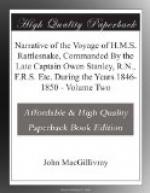Habitat: Bass Strait, 45 fathoms, dead shells.
Of a yellowish white colour, sometimes reddish. Forms fine bushy tufts, with long wavy branches, arising from a short common stem, and it attains a height of five or six inches. It appears sometimes to be parasitic upon other polyzoa, and is then much smaller. Its peculiar characteristics are the perforated and striated scutiform area on the front of the cell and the perforated, or apparently perforated pyramidal lateral processes above each avicularium; these processes are much developed, and give the cell the form of a broad inverted shear-head. It seems to be an abundant species in Bass Strait, and it occurs also in New Zealand. (Dr. Hooker’s Collection.)
2. C. amphora, n. sp.
Cellaria catenulata ? var. B. Lamarck. Anim. sans Vert. Volume 2 page 180 2nd edition.
Cells oval, sides rendered straight upwards by the broad avicularia which are prolonged upwards into an acute spinous angle, and support a shallow cup. Front of cell with nine pyriform fenestrae, with fissures proceeding from their pointed ends towards an oval central perforation. An elevated band, extending from the sides of the mouth to the upper angular processes of the avicularia. An elevated flattened band along the middle of the back, which at the top sends off a narrower lateral band to each avicularian spine.
Habitat: Bass Strait, 45 fathoms.
A fine species of a bright reddish brown, and in the younger cells very transparent. Forms small, irregularly branched bushes, four to six inches high and wide. It is peculiar by its extremely regular vase-like form of cell, which is given by the continuation upwards of the broad avicularia in nearly a straight line, and their prolongation into a sharp angular spine, on the inner side of which is a shallow cup-like cavity, whose sides are usually more horny than calcareous. The number of fenestrae appears to be very constant.
The length of the branches before their dividing, and their straightness, together with the colour of this species, render it not improbable that it is the form intended by Lamarck (l.c.).
3. C. margaritacea, n. sp.
Cellaria vesiculosa ? Lamarck.
Cells oval or sub-globular, much compressed; avicularia short and broad, supporting a deep cup-like cavity. Fenestrae 5, large. Lower margin of mouth notched in the middle; back of cell minutely sulcated; sulci short, interrupted, and irregular. A small lateral area.
Habitat: Swan Island, Banks Strait.
A very beautiful species, the branches resembling strings of minute pearls. The pearly lustre (in the dry state) owing without doubt to the minute sulci on the backs of the cells. These sulci are not, however, consequent upon the drying, because they are equally apparent and constant when the specimen has been immersed in fluid. The species may almost at once be distinguished by the notch in the lower margin of the mouth, which notch represents the central suboral opening present in some other species.




